Onkyo TX-NR474 operation manual
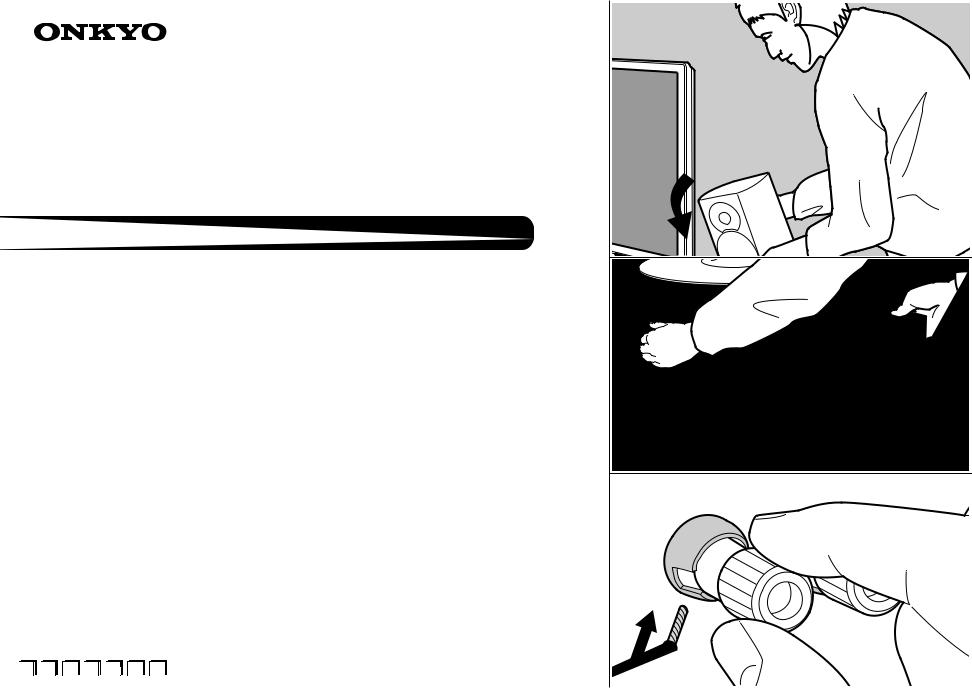
TX-NR474
AV RECEIVER
Instruction Manual Mode d’emploi
Manual de instrucciones Manuale di istruzioni Bedienungsanleitung Gebruikershandleiding Grundläggande bruksanvisning
En Fr Es It |
De Nl |
Sv |

> Before Start > Part Names > Install > Initial Setup > Playback
Advanced Setup | Supplementary Information | Others
Table of Contents
Before Start ............................................................ |
2 |
What's in the box ..................................................... |
3 |
Part Names ............................................................ |
4 |
Part Names ............................................................. |
4 |
Install ...................................................................... |
8 |
Installation procedure .............................................. |
8 |
Step1: Speaker Layout ............................................ |
9 |
Step2: Connect the Speakers ............................... |
14 |
Step3: Connect the TV & AV Components ............ |
15 |
Initial Setup .......................................................... |
20 |
Initial Setup with Auto Start-up Wizard .................. |
20 |
Playback .............................................................. |
22 |
AV Component Playback ...................................... |
22 |
BLUETOOTH® Playback ...................................... |
23 |
Internet Radio ....................................................... |
24 |
Spotify ................................................................... |
26 |
AirPlay® ................................................................. |
27 |
USB Storage Device ............................................. |
28 |
Listening To the AM/FM Radio .............................. |
29 |
Music Server ......................................................... |
32 |
Supplementary information for player functions .... |
34 |
Listening Mode ...................................................... |
35 |
Advanced Setup .................................................. |
52 |
Setup Menu ........................................................... |
52 |
Quick Menu ........................................................... |
66 |
Web Setup ............................................................ |
68 |
Firmware Update .................................................. |
69 |
Supplementary Information ............................... |
72 |
Supplementary Information ................................... |
72 |
Others .................................................................. |
73 |
Troubleshooting .................................................... |
73 |
General Specifications .......................................... |
78 |
Reference Information .......................................... |
80 |
2

> Before Start > Part Names > Install > Initial Setup > Playback
Advanced Setup | Supplementary Information | Others
What's in the box
1. Main unit (1)
1 2. Remote controller (RC-956R) (1), batteries (AAA/R03)
(2)
3.Speaker setup microphone (1) 0 Used during Initial Setup.
4.Indoor FM antenna (1)
5. AM loop antenna (1)
0 Quick Start Guide (1)
* This document is an online instruction manual. It is not included as an accessory.
0 Connect speakers with 4 ≠ to 16 ≠ impedance.
0The power cord must be connected only after all other cable connections are completed.
2 |
3 |
0 |
We will not accept responsibility for damage arising from |
|
|
|
the connection of equipment manufactured by other |
|
|
|
companies. |
|
|
0 |
Functionality may be introduced by firmware updates |
|
|
|
and service providers may cease services, meaning that |
|
|
|
some network services and content may become |
|
|
|
unavailable in the future. Furthermore, available services |
4 |
5 |
|
may vary depending on your area of residence. |
|
|
0 |
Details on the firmware update will be posted on our |
|
|
|
website and through other means at a later date. |
|
|
0 |
Specifications and appearance are subject to change |
|
|
|
without prior notice. |
0We plan to provide support for the Dolby Atmos audio format through firmware updates for this product. Refer to our website for more information.
En 3
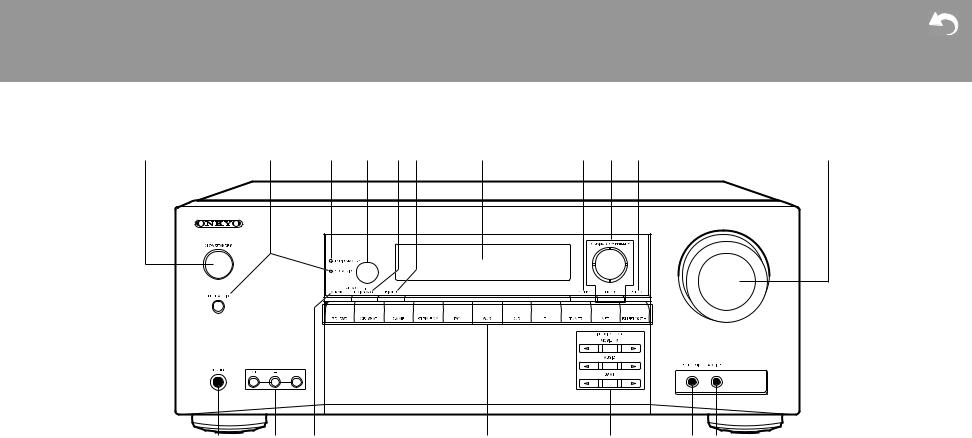
> Before Start > Part Names > Install > Initial Setup > Playback
Advanced Setup | Supplementary Information | Others
Part Names
|
|
|
|
|
|
|
|
|
|
|
Front Panel
1.Í ON/STANDBY button
2.PURE AUDIO button/indicator: Switches the unit to Pure Audio mode (P38).
3.HYBRID STANDBY indicator: Lights if the unit enters standby mode when the features are enabled that continue to work when this unit is in standby, such as HDMI Standby Through and Network Standby.
4.Remote control sensor: Receives signals from the remote controller.
0The signal range of the remote controller is within about 16y/5 m, at an angle of 20° on the perpendicular axis and 30° to either side.
5.TUNING MODE button: Switches tuning to an AM/FM station between automatic tuning and manual tuning.
6.DIMMER button: You can adjust the brightness of the display in three steps. It cannot be turned off completely.
7.Display(P5)
8.SETUP button: You can show advanced setting items on the TV and display to provide you with an even better experience (P52).
9.Cursors (S / T / W / X), ENTER button: Select the item with the cursors and press ENTER to confirm. Use them to tune to stations when using TUNER (P29).
10.RETURN button: Returns the display to the previous state during setting. 11.MASTER VOLUME
12.PHONES jack: Connect stereo headphones with a standard plug (Ø 1/4z/6.3 mm diameter).
13.TONE and Tone Level buttons: You can adjust the sound quality of the front speakers. Press TONE to select the desired setting from "Bass" and "Treble", and adjust with the Tone Level buttons (-/+).
14.MEMORY button: Used to register AM/FM radio stations. 15.Input selector buttons: Switches the input to be played.
4

> Before Start > Part Names > Install > Initial Setup
16.LISTENING MODE buttons: Select listening modes |
|
|
|
|
(P35). |
||||
|
|
|
||
17.SETUP MIC jacks: Connect the supplied speaker |
|
|
|
|
setup microphone. |
|
|
|
|
18.AUX INPUT jacks: |
|
|
|
|
Connect a video camera, etc., using a stereo mini plug |
|
|
|
|
cable (Ø 1/8z/3.5 mm). |
|
|
|
> Playback
Advanced Setup | Supplementary Information | Others
|
|
|
Display
1.Speaker/Channel display: Displays the output channel that corresponds to the selected listening mode.
2.Lights in the following conditions. Ë: When headphones are connected
 : When connected via BLUETOOTH
: When connected via BLUETOOTH
 : When connected by Wi-Fi
: When connected by Wi-Fi
NET: When "NET" is selected with the input selector and the unit is connected to the network. It will flash if the connection to the network is not correct.
USB: When "NET" is selected with the input selector and the unit is connected by USB and the USB device is selected. Flashes if the USB is not properly connected.
HDMI: HDMI signals are input and the HDMI input selector is selected. DIGITAL: Digital signals are input and the digital input selector is selected.
3.Lights according to the type of input digital audio signals and the listening mode.
4.Lights in the following conditions. RDS: Receiving RDS broadcasting. TUNED: Receiving AM/FM radio. FM ST: Receiving FM stereo. SLEEP: Sleep timer has been set.
AUTO STBY: Auto Standby has been set.
5.Flashes when muting is on.
6.Displays various information of the input signals.
7.This may light when performing operations with the "NET" input selector.
En 5
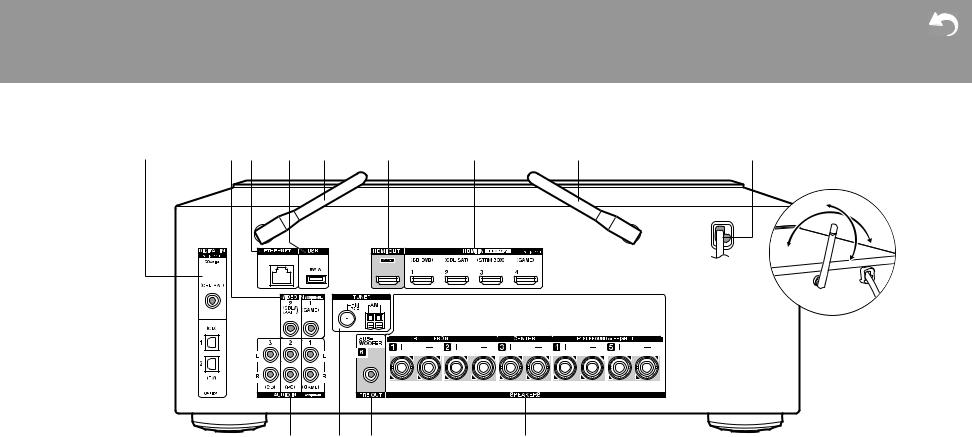
> Before Start > Part Names > Install > Initial Setup > Playback
Advanced Setup | Supplementary Information | Others
|
|
|
|
|
|
|
|
|
|
|
|
|
|
|
|
90° |
|
Rear Panel
1.DIGITAL IN OPTICAL/COAXIAL jacks: Input TV or AV component digital audio signals with a digital optical cable or digital coaxial cable.
2.VIDEO IN jacks: Input the video signals of an AV component with an analog video cable.
3.ETHERNET jack: Connect to the network with an Ethernet cable.
4.USB jack: A USB storage device is connected so that music files stored in it can be played. You can also supply power (5 V/1 A) to USB devices with a USB cable.
5.Wireless antenna: Raise for Wi-Fi connection or when using a BLUETOOTH wireless technology enabled device. Adjust their angles according to the connection status.
6.HDMI OUT jack: Connect a HDMI cable to transfer video signals and audio signals to a TV.
7.HDMI IN jacks: Input video signals and audio signals with a HDMI cable connected to an AV component.
8.Power cord
9.AUDIO IN jacks: Input AV component audio signals with an analog audio cable. 10.TUNER AM/FM 75≠ jacks: Connect the supplied antenna.
11.SUBWOOFER PRE OUT jack: Connect a powered subwoofer with a subwoofer cable. 12.SPEAKERS jacks: Connect speakers with speaker cables.
6

> Before Start > Part Names > Install > Initial Setup > Playback
Advanced Setup | Supplementary Information | Others
|
|
|
|
|
|
|
|
|
|
|
|
|
|
|
|
|
|
|
|
|
|
|
|
Remote Controller |
|
|
|
|
|
|
|
|
|
|
|
|
|
|
|
|
|
|
|
1. Í ON/STANDBY button |
|
||||||||
|
|
|
|
|
|
|
|
|
|
|
|
|
|
|||||||||||||
|
|
|
|
|
|
|
|
|
|
|
|
|
|
|
|
|
|
|
|
|
|
|
|
2. Input selector buttons: Switches the input to be played. |
||
|
|
|
|
|
|
|
|
|
|
|
|
|
|
|
|
|
|
|
|
|
|
|
|
3. Q (QUICK MENU) button: Settings such as "Tone" and |
||
|
|
|
|
|
|
|
|
|
|
|
|
|
|
|
|
|
|
|
|
|
|
|
|
|
"Level" can be made quickly during play on the TV screen |
|
|
|
|
|
|
|
|
|
|
|
|
|
|
|
|
|
|
|
|
|
|
|
|
|
|
(P66). |
|
|
|
|
|
|
|
|
|
|
|
|
|
|
|
|
|
|
4. Cursors, ENTER button: Select the item with the cursors and |
|||||||||
|
|
|
|
|
|
|
|
|
|
|
|
|
|
|
|
|
|
|
|
|
|
|
|
|
press ENTER to confirm. When the folder or file lists are not |
|
|
|
|
|
|
|
|
|
|
|
|
|
|
|
|
|
|
|
|
|
|
|
|
|
|
shown on one screen on the TV, press W/X to change the |
|
|
|
|
|
|
|
|
|
|
|
|
|
|
|
|
|
|
|
|
|
|
|
|
|
|
screen. |
|
|
|
|
|
|
|
|
|
|
|
|
|
|
|
|
|
|
|
|
|
|
|
|
|
5. |
button: You can show advanced setting items on the TV |
|
|
|
|
|
|
|
|
|
|
|
|
|
|
|
|
|
|
|
|
|
|
|
|
|
|||
|
|
|
|
|
|
|
|
|
|
|
|
|
|
|
|
|
|
|
|
|
|
|
|
|||
|
|
|
|
|
|
|
|
|
|
|
|
|
|
|
|
|
and display to provide you with an even better experience |
|||||||||
|
|
|
|
|
|
|
|
|
|
|
|
|
|
|
|
|
|
|
|
|
|
|
|
|
(P52). |
|
|
|
|
|
|
|
|
|
|
|
|
|
|
|
|
|
|
|
|
|
|
|
|
|
6. Volume buttons |
|
|
|
|
|
|
|
|
|
|
|
|
|
|
|
|
|
|
|
|
|
|
|
|
|
|
7. |
button: Temporarily mutes audio. Press again to cancel |
|
|
|
|
|
|
|
|
|
|
|
muting. |
|
|||||||||||||||
|
|
|
|
|
|
|
|
|
|
|||||||||||||||||
|
|
|
|
|
|
|
|
|
|
|
|
|
|
|
|
|
|
|
|
|
|
|
|
8. LISTENING MODE buttons: Select listening modes (P35). |
||
|
|
|
|
|
|
|
|
|
|
|
|
|
|
|
|
|
|
|
|
|
|
|
|
9. Play button: Used for play operations when playing Music |
||
|
|
|
|
|
|
|
|
|
|
|
|
|
|
|
|
10. |
Server or USB. |
|
||||||||
|
|
|
|
|
|
|
|
|
|
|
|
|
|
|
|
|
|
|
|
|
|
|
|
button: Used for repeat or random play operations |
||
|
|
|
|
|
|
|
|
|
|
|
|
|
|
|
|
|
|
|
|
|
|
|
|
|
when playing Music Server or USB. Each time you press the |
|
|
|
|
|
|
|
|
|
|
|
|
|
|
|
|
|
|
|
|
|
|
|
|
|
|
button, the mode switches from |
(1-track repeat), to |
|
|
|
|
|
|
|
|
|
|
|
|
|
|
|
|
|
|
|
|
|
|
|
|
|
(folder repeat), to (random). |
|
|
|
|
|
|
|
|
|
|
|
|
|
|
|
|
|
|
|
|
|
|
|
|
|
|
CLEAR button: Deletes all characters you have entered |
|
|
|
|
|
|
|
|
|
|
|
|
when entering text on the TV screen. |
|
||||||||||||||
|
|
|
|
|
|
|
|
|
|
|
||||||||||||||||
|
|
|
|
|
|
|
|
|
|
|
|
|
|
|
|
|
|
|
|
|
|
|
|
11.DIMMER button: You can adjust the brightness of the display |
||
|
|
|
|
|
|
|
|
|
|
|
|
|
|
|
|
in three steps. It cannot be turned off completely. |
||||||||||
|
|
|
|
|
|
|
|
|
|
|
|
|
|
|
|
|
|
|
|
|
|
|
|
|
||
|
|
|
|
|
|
|
|
|
|
|
|
|
|
|
|
|
|
|
|
|
|
|
|
12. |
button: Switches the information on the display and is |
|
|
|
|
|
|
|
|
|
|
|
|
|
|
|
|
|
|
|
|
|
|
|
|
|
used to operate RDS (P30). |
|
|
|
|
|
|
|
|
|
|
|
|
|
|
|
13. |
button: Returns the display to the previous state during |
||||||||||||
|
|
|
|
|
|
|
|
|
||||||||||||||||||
|
|
|
|
|
|
|
|
|
|
|
|
|
|
|
|
|
|
|
|
|
|
|
|
|
setting. |
|
|
|
|
|
|
|
|
|
|
|
|
|
|
|
|
|
|
|
|
|
|
|
|
|
|
||
|
|
|
|
|
|
|
|
|
|
|
|
|
|
|
|
14.MODE button: Switches tuning to an AM/FM station between |
||||||||||
|
|
|
|
|
|
|
|
|
|
|
|
|||||||||||||||
|
|
|
|
|
|
|
|
|
|
|
|
|
automatic tuning and manual tuning. |
|
||||||||||||
|
|
|
|
|
|
|
|
|
|
|
|
|
|
|
|
|
|
|
|
|
|
|
|
15.MEMORY button: Used to register AM/FM radio stations. |
||
|
|
|
|
|
|
|
|
|
|
|
|
|
|
|
|
|
|
|
|
|
|
|
|
|||
0 MAIN and ZONE buttons are not used.
En 7

> Before Start > Part Names > Install > Initial Setup > Playback
Advanced Setup | Supplementary Information | Others
Installation procedure
1
2 |
3 |
This unit can be used in a number of ways, depending on the layout of the speakers you are installing, and the connections made to external devices. Read the following to help make the installation process smoother.
Step1: Speaker Layout
Select the speaker layout that suits the types of speakers you have and the conditions they will be used in from the choices presented on pages P9 to P12, then install the speakers by referring to the illustrations and explanations on the relevant page. Speaker layouts include systems that use surround speakers and systems that use height speakers. Also refer to the combinations available in "Speaker combinations" on P13.
Step2: Connect the Speakers
Connect the speaker system to this unit. The connection process will be smoother if you refer to the illustrations and explanations and prepare the required cables before hand.
Step3: Connect the TV & AV Components
Refer to P15 to P19 to connect your external devices such as your TV, Blu-Ray Disc Player, and also supplied accessories such as the antennas. The connection process will be smoother if you refer to the illustrations and explanations, confirm the connection types on the external devices, and prepare the required cables before hand.
8

> Before Start > Part Names > Install > Initial Setup > Playback
Advanced Setup | Supplementary Information | Others
Step1: Speaker Layout
5.1 Channel System
1
2
¢1: 22° to 30°, ¢2: 120°
Front speakers output front stereo sound and the center speaker outputs sounds emanating from the center of the screen, such as dialog and vocals. Surround speakers create the sound field at the rear. The powered subwoofer reproduces bass sounds and enriches the sound field. The optimal positioning for front speakers is at ear height, and for surround speakers it is just above ear height. The center speaker should be set up at an angle to face the listening position. Placing the powered subwoofer between the center speaker and a front speaker gives you a natural sound even when playing music.
1,2 Front Speakers
3 Center Speaker
4,5 Surround Speakers
6Powered Subwoofer
En 9
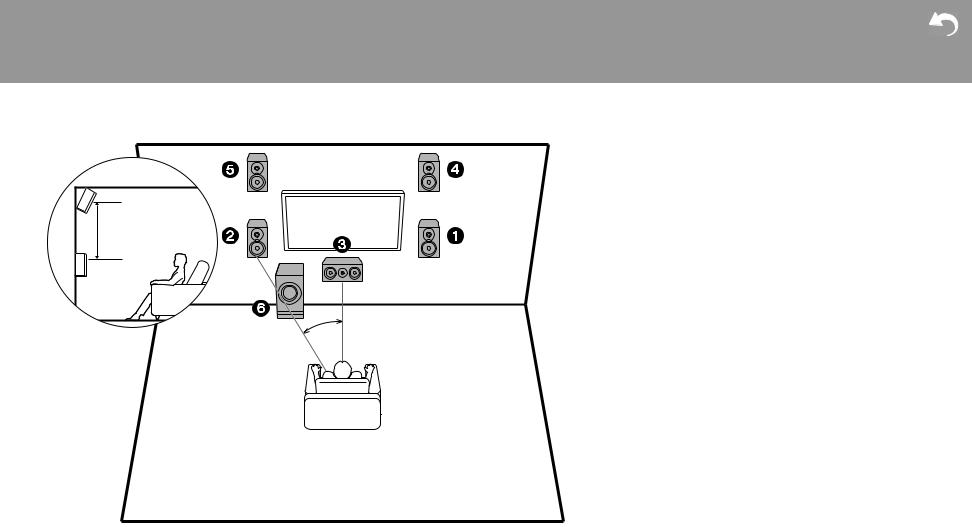
> Before Start > Part Names > Install > Initial Setup > Playback
Advanced Setup | Supplementary Information | Others
|
3.1.2 Channel System-1 |
||
|
(Front High Speakers) |
||
|
This is a 3.1-channel system consisting of front speakers, a |
||
|
center speaker, and a powered subwoofer, with the addition |
||
|
of front high speakers, a type of height speaker. Front high |
||
3´ (0.9 m) |
speakers should be situated at least 3y/0.9 m higher than |
||
the front speakers. They should also be put directly above |
|||
or more |
|||
the front speakers, angled to face the listening position. |
|||
|
|||
|
0 We plan to provide support for the Dolby Atmos audio |
||
|
|
format through firmware updates for this unit. After this |
|
|
|
firmware update, by installing height speakers, you can |
|
|
|
select the Dolby Atmos listening mode, which realizes |
|
|
1 |
the most up-to-date 3D sound including overhead |
|
|
sounds, when the input format is Dolby Atmos. Visit our |
||
|
|
website for details about firmware updates. |
|
|
1,2 Front Speakers |
||
|
3 |
Center Speaker |
|
|
4,5 Front High Speakers |
||
|
6 |
Powered Subwoofer |
|
¢1: 22e to 30e
10

> Before Start > Part Names > Install > Initial Setup > Playback
1
¢1: 65° to 100°
Advanced Setup | Supplementary Information | Others
3.1.2 Channel System-2
(Ceiling Speakers)
This is a 3.1-channel system consisting of front speakers, a center speaker, and a powered subwoofer, with the addition of top middle speakers, a type of height speaker. Fit top middle speakers on the ceiling directly above the listening position. The distance between each pair should match the distance between the two front speakers.
0We plan to provide support for the Dolby Atmos audio format through firmware updates for this unit. After this firmware update, by installing height speakers, you can select the Dolby Atmos listening mode, which realizes the most up-to-date 3D sound including overhead sounds, when the input format is Dolby Atmos. Visit our website for details about firmware updates.
0Dolby Laboratories recommends placing this type of height speakers to obtain the best Dolby Atmos effect.
1,2 Front Speakers
3Center Speaker
4,5 Top Middle Speakers
6Powered Subwoofer
En 11

> Before Start > Part Names > Install > Initial Setup > Playback
Advanced Setup | Supplementary Information | Others
3.1.2 Channel System-3
(Dolby Enabled Speakers (Dolby Speakers))
This is a 3.1-channel system consisting of front speakers, a center speaker, and a powered subwoofer, with the addition of Dolby enabled speakers (front), a type of height speaker. Dolby enabled speakers are special speakers designed to face the ceiling so that sound is heard after bouncing off the ceiling so that sound appears to be coming from overhead. Place Dolby enabled speakers (front) above the front
speakers. |
|
0 We plan to provide support for the Dolby Atmos audio |
|
|
format through firmware updates for this unit. After this |
1 |
firmware update, by installing height speakers, you can |
select the Dolby Atmos listening mode, which realizes |
|
|
the most up-to-date 3D sound including overhead |
|
sounds, when the input format is Dolby Atmos. Visit our |
|
website for details about firmware updates. |
1,2 Front Speakers |
|
3 |
Center Speaker |
4,5 Dolby Enabled Speakers (Front) |
|
6 |
Powered Subwoofer |
¢1: 22° to 30°
12

> Before Start > Part Names > Install > Initial Setup > Playback
Advanced Setup | Supplementary Information | Others
Speaker combinations
Speaker Channels |
FRONT |
CENTER |
SURROUND |
HEIGHT |
2.1 ch
3.1 ch
4.1 ch
5.1 ch
2.1.2 ch
3.1.2 ch
En 13
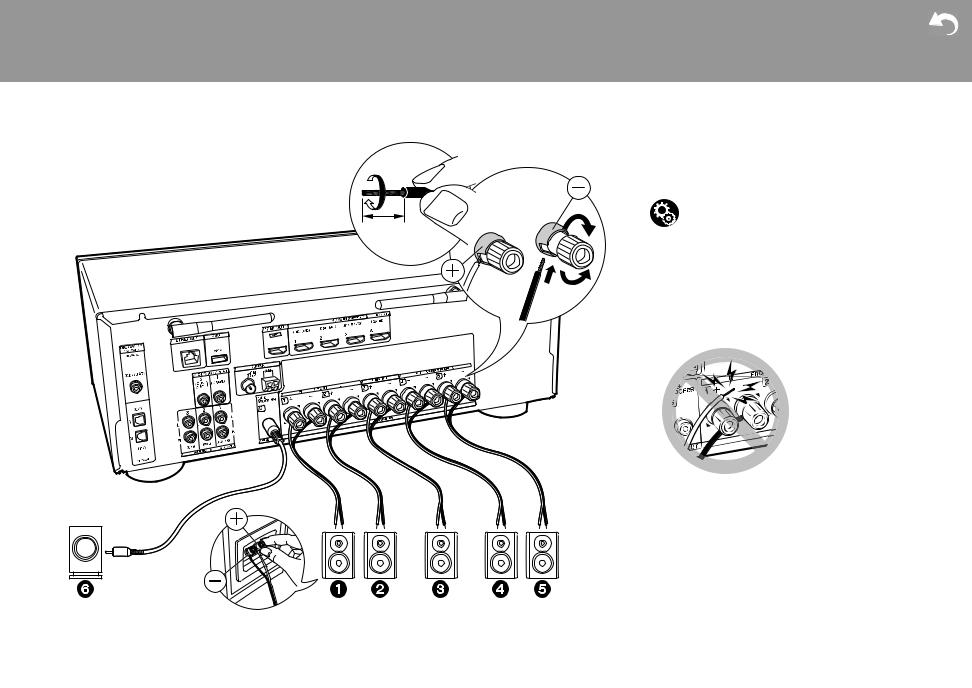
> Before Start > Part Names > Install > Initial Setup > Playback
Advanced Setup | Supplementary Information | Others
Step2: Connect the Speakers
1/2˝ (12 mm)
a
b
a Speaker cable, b Subwoofer cable
Make correct connection between the unit's jacks and speaker's jacks (+ to + and - to -) for each channel. If connection is wrong, reverse phase may make bass output poor.
Setup
0Settings for the speaker configuration you have connected need to be made in "1. AccuEQ Room Calibration" in Initial Setup (P20).
0If any of the connected speakers have an impedance of 4 ≠ or more to less than 6 ≠, after completing Initial Setup, you need to make some
settings in the Setup menu. Press  on the remote controller, select "2. Speaker" - "Configuration" and set "Speaker Impedance" to "4ohms".
on the remote controller, select "2. Speaker" - "Configuration" and set "Speaker Impedance" to "4ohms".
Connect the speaker cable so the wires do not protrude from the speaker jacks.
If the exposed wires of the speakers touch the rear panel or the + and - wires touch each other, the protection circuit will be activated.
14

> Before Start > Part Names > Install > Initial Setup > Playback
Advanced Setup | Supplementary Information | Others
Step3: Connect the TV & AV Components
a
b
1. Connect the TV
To ARC TV
For a TV that supports the ARC (Audio Return Channel) feature, use an HDMI cable and connect according to illustration "a". Choose an HDMI IN jack on the TV that supports ARC when connecting.
Setup
0Settings are required to use the ARC function. For "4. Audio Return Channel" (P21) in Initial Setup, select "Yes".
0Refer to the instruction manual for the TV for TV connections and instructions regarding settings for CEC features and audio output.
To Non-ARC TV
For a TV that does not support the ARC (Audio Return Channel) feature (*), connect both the HDMI cable in illustration "a" and the digital optical cable in "b".
0Connection with a digital optical cable is not necessary if you will watch TV through a device such as a cable settop box (that is, not use a tuner built into the TV) that you have connected to the input jack on this unit.
(*)The ARC feature: This feature transfers TV audio signals via HDMI cable so that you can play the audio from the TV through this unit. Connection to an ARC compatible TV is complete with one HDMI cable. Refer to the instruction manual for your TV to see if it supports ARC.
TV
a HDMI cable, b Digital optical cable
En 15
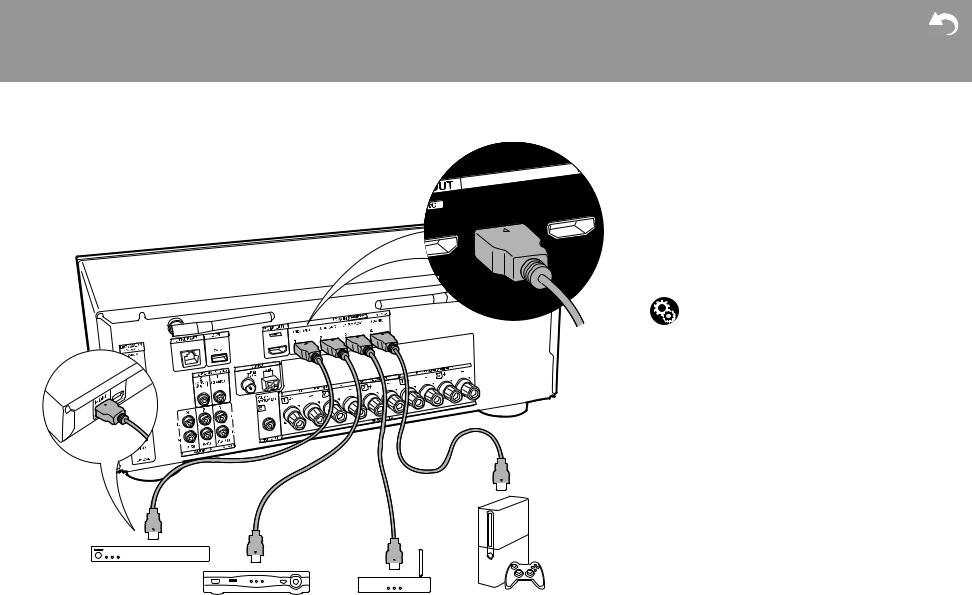
> Before Start > Part Names > Install > Initial Setup > Playback
Advanced Setup | Supplementary Information | Others
2. Connect the HDMI AV Component
a
BD/DVD
Cable/Satellite set-top |
Streaming media |
GAME |
box |
player |
|
a HDMI cable
This is an example of connection with an AV component that has an HDMI jack. With connection to an AV component that conforms with the CEC (Consumer Electronics Control) standard, you can use features such as the HDMI CEC feature (*) that links with the input selector, and the HDMI Standby Through feature which allows you to play video and audio from AV components on the TV even when this unit is in standby mode.
0To play 4K or 1080p video, use the high speed HDMI cable.
Setup
0When "Yes" is selected for "4. Audio Return Channel" in Initial Setup (P21), the HDMI CEC function and HDMI Standby Through function are automatically enabled. If "No, Skip" is selected, settings are required in the Setup menu after
Initial Setup is complete. Press  on the remote controller and make the settings in "5. Hardware" - "HDMI".
on the remote controller and make the settings in "5. Hardware" - "HDMI".
0To enjoy digital surround sound including Dolby Digital, audio output should be set to "Bitstream output" on the connected Blu-ray Disc player or other device.
(*)The HDMI CEC feature: You can control features such as linking input switching with the input selector and players conforming to the CEC standard, switching audio to output it from the TV or from this unit, and adjusting the volume using the remote controller of a CEC-compliant TV, and automatically switching this unit to standby when the TV is turned off.
16

> Before Start > Part Names > Install > Initial Setup > Playback
Advanced Setup | Supplementary Information | Others
3. Connect the Non-HDMI AV Component
This is an example of connection with an AV component that does not have an HDMI jack. Select the cables to make the connections to the AV component to match the jacks it has. When video input connection is to the CBL/SAT jack, the audio input connection should also be to the CBL/SAT jacks, and so on, so that you connect the video input jacks to the jacks with the same name as the audio input jacks. Note that video signals input to the VIDEO IN jack will be converted to HDMI video signals and then output from the HDMI OUT output jack.
0 To enjoy digital surround playback, such as Dolby Digital, the audio signals need to pass through a connection via digital coaxial cable or digital optical cable.
0 It is possible to change assignment of the input jacks you see in the illustration at left, so you can also connect to any jack other than CBL/SAT (P53, 54).
Setup
0 To enjoy digital surround sound including Dolby Digital, audio output should be set to "Bitstream output" on the connected Cable/Satellite set-top box or other device.
a
b
Cable/Satellite set-top box
a Analog video cable, b Digital coaxial cable
En 17
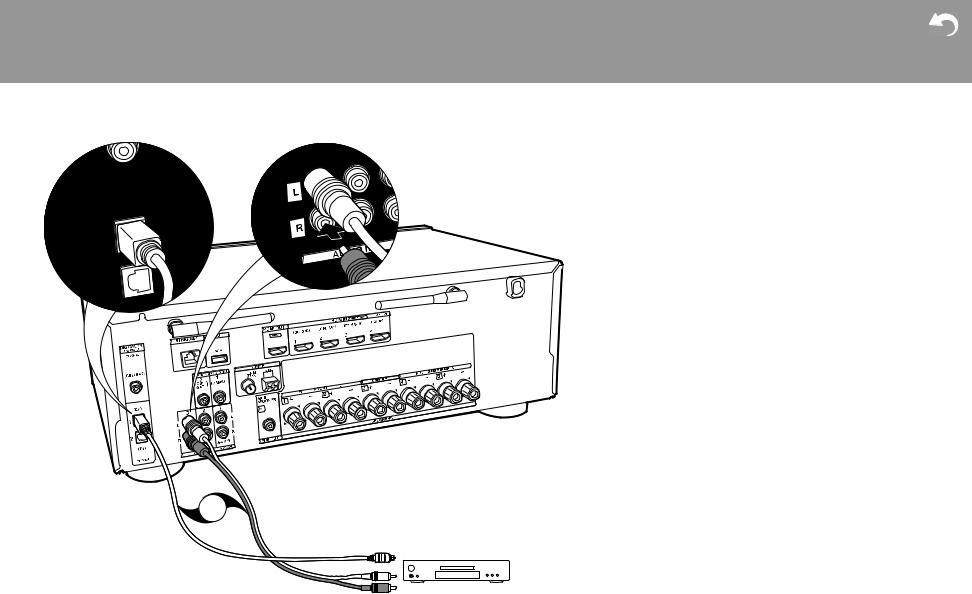
> Before Start > Part Names > Install > Initial Setup > Playback
Advanced Setup | Supplementary Information | Others
4. Connect the Audio Component
Example of a connection with an Audio component. Connect a CD player using a digital optical cable or analog audio cable.
a OR b
CD
a Digital optical cable, b Analog audio cable
18
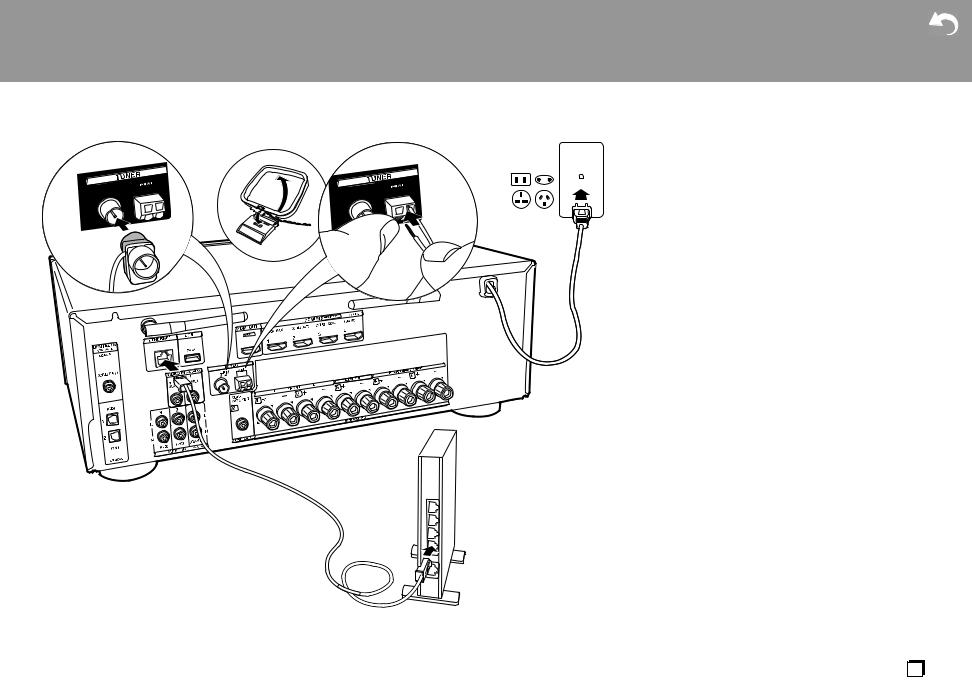
> Before Start > Part Names > Install > Initial Setup > Playback
Advanced Setup | Supplementary Information | Others
|
5. Connect Other Cables |
|
|
Antenna Hookup |
|
|
Move the antenna around while playing the radio to find the |
|
|
position with the best reception. Use a thumb tack or similar |
|
b |
to attach the FM indoor antenna to a wall. |
|
Network Hookup |
||
a |
||
Connect this unit to the network using wired LAN or Wi-Fi |
||
|
(wireless LAN). You can enjoy Network Functions such as |
|
|
internet radio by connecting to the network. If you connect |
|
|
by wired LAN, connect to the router with an Ethernet cable |
|
|
to the ETHERNET port as shown in the illustration. To |
|
|
connect by Wi-Fi, after selecting "Wireless" in "3. Network |
|
|
Connection" (P21) in Initial Setup, select the desired setting |
|
d |
method and follow the onscreen instructions to configure |
|
the connection. |
||
|
Power Cord Hookup |
|
|
The power cord must be connected only after all other |
|
|
connections are completed. |
c
a FM indoor antenna, b AM indoor antenna, c Ethernet cable, d Power cord
En 19
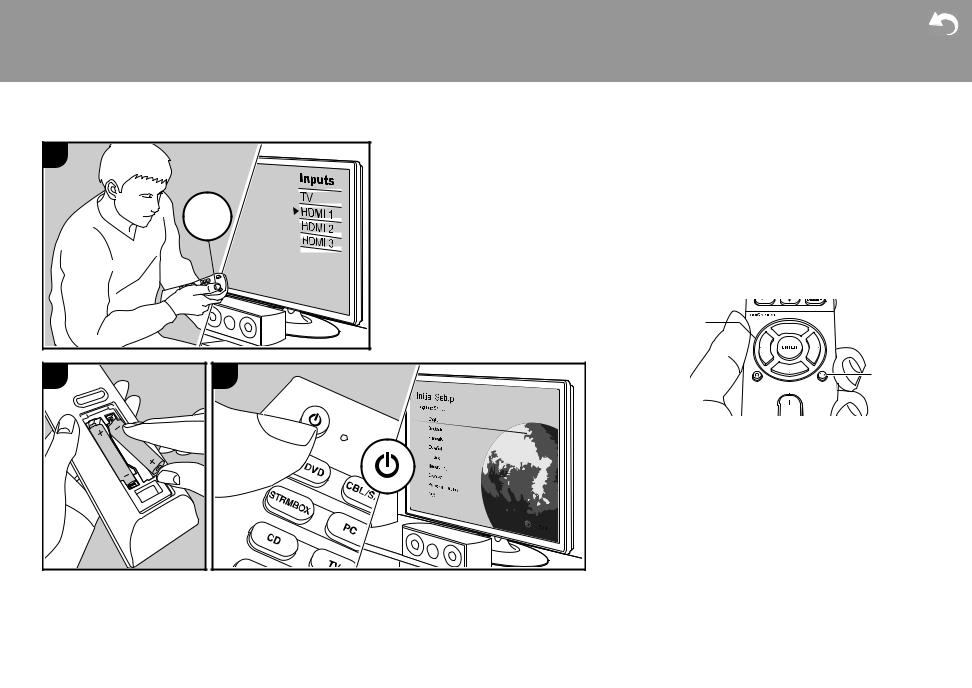
> Before Start > Part Names > Install > Initial Setup > Playback
Advanced Setup | Supplementary Information | Others
Initial Setup with Auto Start-up Wizard
1 |
|
|
INPUT |
|
TV |
2 |
3 |
Initial Setup starts automatically
When you turn the unit on for the first time after purchasing it, Initial Setup is automatically shown on the TV to enable you to make settings required for startup using simple operations following onscreen guidance.
1.Switch the input on the TV to that assigned to the unit.
2.Put batteries into the remote controller of this unit.
3.Press Í on the remote controller to turn the unit on.
4.Select the item with the cursors of the remote controller and press ENTER (a) to confirm your selection. To return to the previous screen, press  (b).
(b).
a


b
0If you terminate the procedure on the way or want to
change a setting made during Initial Setup, press  on the remote controller, and select "6. Miscellaneous" - "Initial Setup" and press ENTER. To select the language displayed again, change "OSD Language" (P52).
on the remote controller, and select "6. Miscellaneous" - "Initial Setup" and press ENTER. To select the language displayed again, change "OSD Language" (P52).
∫ 1. AccuEQ Room Calibration
Place the supplied speaker setup microphone in the listening position, measure the test tones emitted by the speakers, then the unit automatically sets the optimum volume level for each speaker, the crossover frequencies, and the distance from the listening position. This also automatically adjusts the equalizers for the speakers and enables correction of distortion caused by the acoustic environment of the room.
20
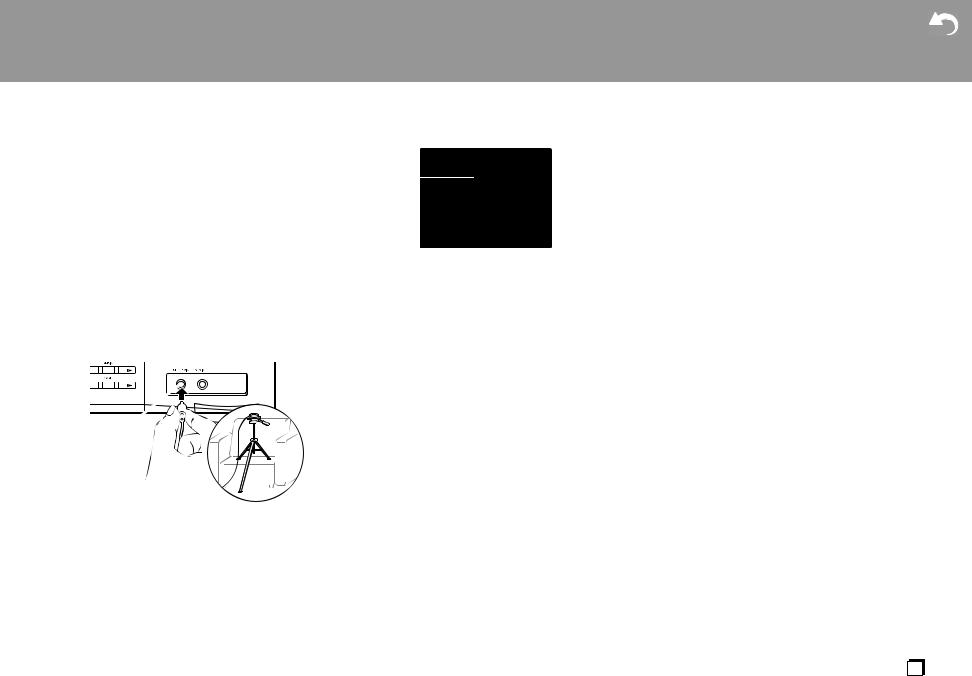
> Before Start > Part Names > Install > Initial Setup > Playback
Advanced Setup | Supplementary Information | Others
0Calibration takes between 3 and 12 minutes to be completed. The speakers emit the test tone at high volume during measurement, so be careful of your surroundings. Also, keep the room as quiet as possible during measurement.
0If you have connected a subwoofer, check the power and volume of the subwoofer. Set the subwoofer volume to more than halfway.
0If the power of this unit suddenly turns off, the wires in the speaker cables may have touched the rear panel or other wires and tripped the protection circuit. Twist the wires again properly and make sure they do not stick out of the speaker terminals when connecting.
1.Place the supplied speaker setup microphone in the listening position, and connect to the SETUP MIC jack on the main unit.
SETUP MIC
When putting the speaker setup microphone on a tripod, refer to the illustration when putting it in place.
2. Select the connected speaker configuration.
AccuEQ Room Calibration
Speaker Channels |
5.1 ch < > |
|
|
Subwoofer |
Yes |
|
|
Height Speaker |
--- |
|
|
|
|
||
|
|||
|
|
|
|
Select how many speakers you have.
Next
The image on the screen changes as you choose the number of channels in "Speaker Channels", so refer to it when performing the settings.
3.Test tones are emitted by the speakers, and firstly the unit detects the speakers connected and the noise in the environment.
4.After the results of the measurements in step 3 above are displayed, select "Next", press ENTER on the remote controller, and the test tones are emitted again, and the unit automatically makes settings such as the optimum volume level and the crossover frequency.
5.When the measurement is completed, the measurement result is displayed. Press the cursors W / X on the remote controller to check the settings. Select "Save" and press ENTER to save the settings.
6.Select whether to enable or disable the equalizer function that corrects for distortion caused by the acoustic environment of the room.
If this is to be enabled, then normally you should select "On (All Channels)", and to disable just the front speakers you should select "On (Except Front Left / Right)".
7.Disconnect the speaker setup microphone.
∫ 2. Source Connection
Check that each input source is connected correctly. Follow the guidance, select the input you want to confirm, start play of the selected player, and confirm that the images appear on the TV and that sound is played.
∫ 3. Network Connection
Set up Wi-Fi connection with an access point such as a wireless LAN router. There are the following two methods of connecting by Wi-Fi:
"Scan Networks": Search for an access point from this unit. Find out the SSID of the access point beforehand. "Use iOS Device (iOS7 or later)": Connect by sharing the iOS device's Wi-Fi settings with this unit.
If you select "Scan Networks", there are a further two choices of connection method. Check the following. "Enter Password": Enter the password (or key) of the access point to connect.
"Push Button": If the access point has an automatic connection button, you can connect without entering a password.
0 If the SSID of the access point is not displayed, then in the screen listing the SSIDs, select "Other..." with the X cursor on the remote controller and press ENTER, then follow the onscreen instructions.
Keyboard input
To switch between upper and lower case, select "A/a" on the screen and press ENTER. To select whether to mask the password with "¢" or display it in plain text, press MEMORY on the remote control. Pressing CLEAR will delete all the input characters.
0A confirmation screen asking you to agree to the privacy policy is displayed during network setting. Select "Accept" and press ENTER to indicate agreement.
∫ 4. Audio Return Channel
If you have connected a TV that supports ARC, select "Yes". This unit's ARC setting turns on and you can listen to the TV's audio through this unit.
En 21

> Before Start > Part Names > Install > Initial Setup > Playback
Advanced Setup | Supplementary Information | Others
AV Component Playback
1 |
2 |
|
INPUT |
|
T |
|
V |
Basic operations |
3. Start play on the AV component. |
You can play the audio from AV components such as Blu-ray Disc players through this unit.
Perform the following procedure when the 


 unit is on. a
unit is on. a 

1. Switch the input on the TV to that assigned to the unit.
2. Press the input selector (a) on the
remote controller with the same name as the jack to which you connected the
player to switch the input.
For example, press the BD/DVD button to play the player connected to the BD/
DVD jack. Press TV to listen the TV's sound. To play a device connected to the AUX INPUT jack on the front panel,
press AUX. 0 When the CEC link function works,
the input switches automatically when you have connected a CEC compliant TV and player to this unit using HDMI connection.
22
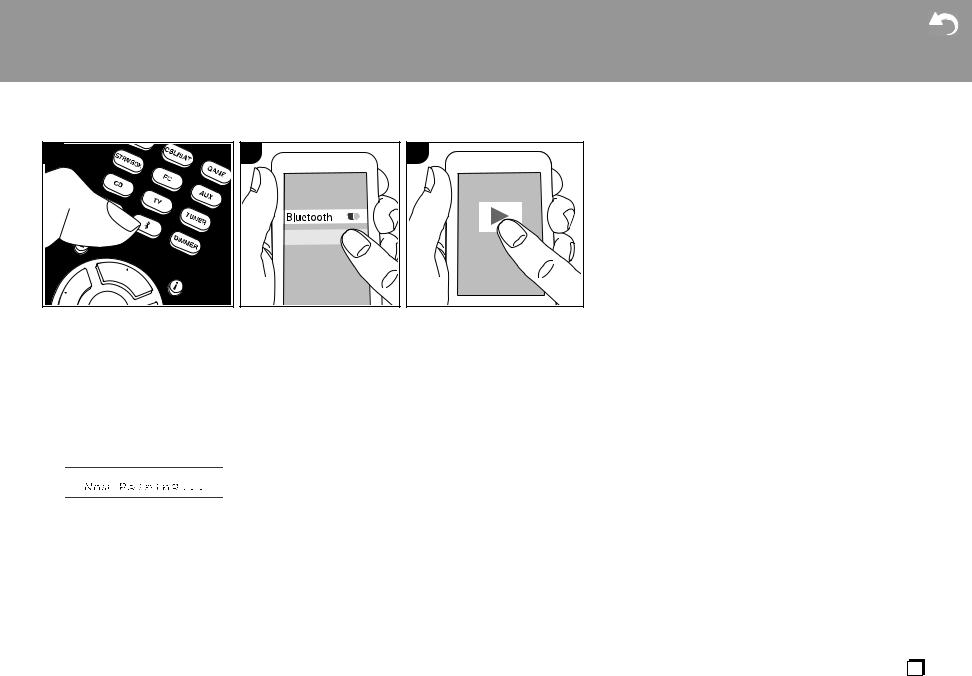
> Before Start > Part Names > Install > Initial Setup > Playback
Advanced Setup | Supplementary Information | Others
BLUETOOTH® Playback |
|
|
1 |
2 |
3 |
|
OnkyoTX-NR474 |
|
You can wirelessly play music on a smartphone or other BLUETOOTH wireless technology enabled device.
Perform the following procedure when the unit is on.
Pairing
1.When you press the  button, "Now Pairing..." is displayed on this unit's display, and the pairing mode is enabled.
button, "Now Pairing..." is displayed on this unit's display, and the pairing mode is enabled.
2.Enable (turn on) the BLUETOOTH function of the BLUETOOTH wireless technology enabled device, then select this unit from amongst the devices displayed. If a password is requested, enter "0000".
0 This unit is displayed as "Onkyo TXNR474 XXXXXX".
0 To connect another BLUETOOTH wireless technology enabled device,
press and hold  until "Now Pairing..." is displayed, then perform step 2. This unit can store the data of up to eight paired devices.
until "Now Pairing..." is displayed, then perform step 2. This unit can store the data of up to eight paired devices.
0The coverage area is 48y/15 meters. Note that connection is not always guaranteed with all BLUETOOTH wireless technology enabled devices.
Playing Back
1.Perform the connection procedure on the BLUETOOTH wireless technology enabled device.
The input on this unit automatically switches to "BLUETOOTH".
2.Play the music files. Increase the volume
of the BLUETOOTH wireless technology enabled device to an appropriate level.
0 Due to the characteristics of BLUETOOTH wireless technology, the sound produced on this unit may slightly be behind the sound played on the BLUETOOTH wireless technology enabled device.
En 23
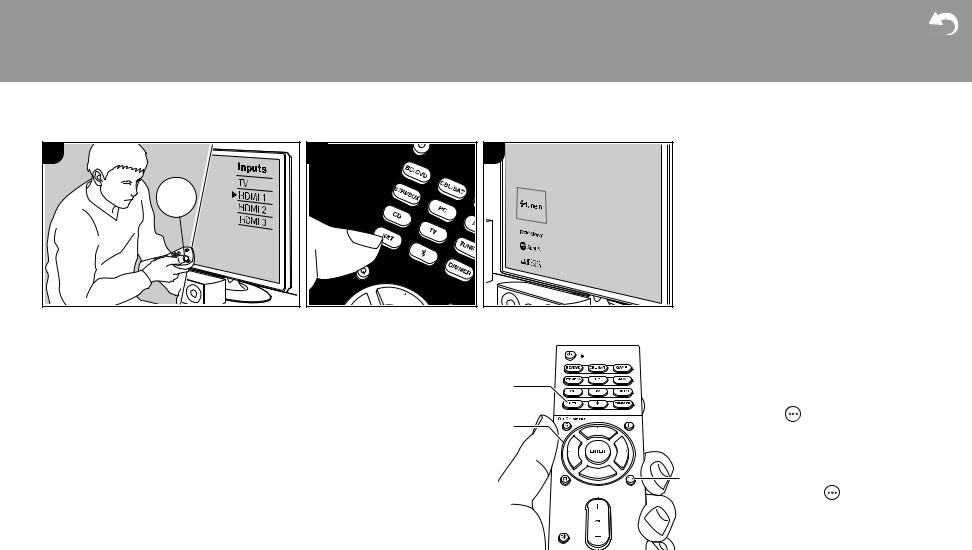
> Before Start > Part Names > Install > Initial Setup > Playback
Advanced Setup | Supplementary Information | Others
Internet Radio
1 |
INPUT |
TV |
2 |
3 |
You can use internet radio services such as TuneIn Radio, Pandora, Deezer, and TIDAL by connecting this unit to a network that has an internet connection.
0The network needs to be connected to the internet in order to play internet radio services.
0Depending on the internet radio service, the user may need to register from their computer first. Refer to the websites for each of the services for details about them.
0Functionality may be introduced by firmware updates and service providers may cease services, meaning that some network services and content may become unavailable in the future.
Playing Back
to display a list of Network Functions on the TV.
3.Select the internet radio service you want with the cursors of the remote controller and press ENTER (b) to confirm your selection.
4.Follow the on-screen instructions, using the cursors to select radio stations and programs, then press ENTER to play.
Play starts when 100% is displayed for buffering.
0To return to the previous screen, press
 (c).
(c).
|
Internet radio service menus |
||
|
You can register certain stations as your |
||
|
favorites or delete stations you have |
||
a |
registered from your favorites. The menu |
||
displayed depends on the service currently |
|||
|
selected. |
|
|
b |
Menu icons |
are displayed at the |
|
bottom right of the screen while playing a |
|||
|
station. When just this icon is displayed, |
||
|
you can display the menu on the screen |
||
c |
just by pressing ENTER on the remote |
||
controller. When multiple icons are |
|||
|
displayed, select an |
icon with the |
|
|
cursors of the remote controller and press |
||
|
ENTER. |
|
|
Regarding the TuneIn Radio
Account
Perform the following procedure when the unit is on.
1.Switch the input on the TV to that assigned to the unit.
2.Press NET (a) on the remote controller
Creating an account on the TuneIn Radio website (tunein.com) and logging in it from the unit allows you to automatically add your favorite radio stations and programs to your "My Presets" on the unit as you
24

> Before Start > Part Names > Install > Initial Setup > Playback
Advanced Setup | Supplementary Information | Others
follow them on the website. "My Presets" are displayed in the level under TuneIn Radio.
To display a radio station registered in "My Presets", you must log into TuneIn Radio from the unit. To log in, select "Login" - "I have a TuneIn account" in the "TuneIn Radio" top list on the unit, and then enter your user name and password.
0If you select "Login" on this unit, you can use the displayed registration code to associate this device on the My Page section of the TuneIn Radio website so that you can login to "Login" - "Login with a registration code" without having to enter your user name and password.
En 25

> Before Start > Part Names > Install > Initial Setup > Playback
Advanced Setup | Supplementary Information | Others
Spotify
1 |
2 |
3 |
4 |
Wi-Fi |
Onkyo TX-NR474 |
Devic |
|
Devices Available |
|
Spotify Connect play is possible by connecting this unit to the same network as a smart phone or tablet.
0To play Spotify Connect, you need to install the Spotify application on your smartphone or tablet. You also need to create a Spotify premium account.
–Refer to the following for Spotify settings: www.spotify.com/connect/
Playing Back
1.Connect the smartphone to the access point that this unit is connected to.
2.Start the Spotify app.
3.Play the track in the Spotify app, then after switching to the screen for controlling play, tap "Devices Available" at the bottom of the screen.
4.Select this unit.
5.This unit turns on automatically and the input selector changes to NET and streaming of Spotify starts.
0If "5. Hardware" - "Power Management" - "Network Standby" is set to "Off" in the
Setup menu, manually turn the unit on and then press NET on the remote controller.
26

> Before Start > Part Names > Install > Initial Setup > Playback
Advanced Setup | Supplementary Information | Others
AirPlay®
1
Wi-Fi
2 |
3 |
4 |
|
iPhone |
|
OnkyoTX-NR474 |
|
e.g., iOS 10 |
Basic operations
You can wirelessly enjoy the music files on an iPhone®, iPod touch®, or iPad® connected to the same access point as this unit.
0Update the OS version on your iOS device to the latest version.
0There may be some differences in the operations screens and how operations are performed on the iOS device depending on the iOS version. For details, see the operating instructions for
the iOS device.
1.Connect the iOS device to the access point.
2.Press NET.
3.Tap the AirPlay icon  in the play screen of the music app on the iOS device and select this unit from the list of devices displayed.
in the play screen of the music app on the iOS device and select this unit from the list of devices displayed.
4.Play the music files on the iOS device. 0 The default status is for the Network
Standby feature to be on, so when you do steps 3 and 4 above, this unit
automatically comes on and input switches to "NET". To reduce the amount of power consumed in standby mode, press the  button on the remote controller, then in the Setup menu displayed set "5. Hardware" -"Power Management" -"Network Standby" to "Off".
button on the remote controller, then in the Setup menu displayed set "5. Hardware" -"Power Management" -"Network Standby" to "Off".
0 Due to the characteristics of AirPlay wireless technology, the sound produced on this unit may slightly be behind the sound played on the AirPlay-enabled device.
You can also play the music files on a computer with iTunes (Ver. 10.2 or later). Before operation, make sure this unit and the PC are connected to the same network, then press NET on this unit. Next, click the AirPlay icon  in iTunes, select this unit from the list of devices displayed, and start play of a music file.
in iTunes, select this unit from the list of devices displayed, and start play of a music file.
En 27
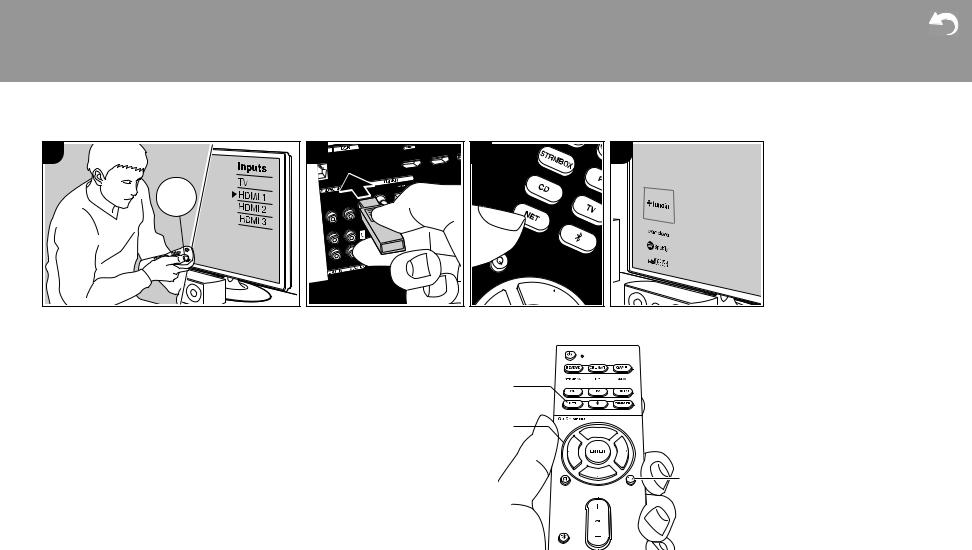
> Before Start > Part Names > Install > Initial Setup > Playback
Advanced Setup | Supplementary Information | Others
USB Storage Device
1 |
INPUT |
T |
V |
2 |
3 |
4 |
Basic operations
You can play music files stored on a USB storage device.
Perform the following procedure when the unit is on.
1.Switch the input on the TV to that assigned to the unit.
2.Plug your USB storage device with the music files into the USB port of this unit’s rear panel.
3.Press NET (a) on the remote controller to display the network service list screen.
4.With the cursors on the remote controller, select "USB", and then press ENTER (b).
0 If the "USB" indicator flashes on the display, check whether the USB storage device is plugged in properly.
0 Do not unplug the USB storage device while "Connecting···" is on the display. This may cause data corruption or malfunction.
5.Press ENTER on the remote controller again in the next screen. The list of folders and music files on the USB storage device are displayed. Select the folder with the cursors and press ENTER to confirm your selection.
6.With the cursors on the remote controller, select the music file, and then
press ENTER to start playback.
0To return to the previous screen, press
 (c).
(c).
0The USB port of this unit conforms with the USB 2.0 standard. The transfer speed may be insufficient for some content you play, which may cause some interruption in sound.
0Note that operation is not guaranteed with all USB storage devices.
0This unit can use USB storage devices that comply with the USB mass storage device class standard. The unit is also compatible with USB storage devices using the FAT16 or FAT32 file system formats.
a


b


c
28

> Before Start > Part Names > Install > Initial Setup > Playback
Advanced Setup | Supplementary Information | Others
Listening To the AM/FM Radio |
|
1 |
2 |
You can receive FM and AM radio stations |
lights. |
on this unit with the built-in tuner. Perform |
When FM broadcasts reception is poor: |
the following procedure when the unit is on. |
|
|
Perform the procedure for "Tuning |
∫ Tuning into a Radio Station |
Manually" in the following section. Note |
that if you tune manually, the reception for |
|
Tuning Automatically |
FM broadcasts will be monaural rather than |
stereo, irrespective of the sensitivity of the |
|
1. Repeatedly press TUNER (a) on the |
reception. |
|
|
remote controller and select "AM" or |
Tuning Manually |
"FM". |
If you tune manually, the reception for FM |
2. Press MODE (e) on the remote |
|
controller so that "TunMode:Auto" |
broadcasts will be monaural rather than |
appears on the display. |
stereo, irrespective of the sensitivity of the |
|
reception. |
|
1. Repeatedly press TUNER (a) on the |
|
remote controller and select "AM" or |
3. When you press the cursor S/T buttons |
"FM". |
2. Press MODE (e) on the remote |
|
(b) on the remote controller, automatic |
controller so that "TunMode:Manual" |
tuning starts, and searching stops when |
appears on the display. |
a station is found. When tuned into a |
|
radio station, the "TUNED" indicator on |
|
the display lights. When tuned into an |
|
FM radio station, the "FM ST" indicator |
|
3 |
3.While pressing the cursor S/T buttons
(b) on the remote controller, select the
desired radio station. |
a |
0 The frequency changes by 1 step |
|
each time you press S/T. The |
b |
frequency changes continuously if the |
button is held down and stops when the button is released.
Frequency step setting
Press  on the remote controller, then use the cursor buttons and ENTER on the remote controller to select "6. Miscellaneous" - "Tuner" - "AM Frequency Step", and select the frequency step for your region. Note that when this setting is changed, all radio presets are deleted.
on the remote controller, then use the cursor buttons and ENTER on the remote controller to select "6. Miscellaneous" - "Tuner" - "AM Frequency Step", and select the frequency step for your region. Note that when this setting is changed, all radio presets are deleted.
c |
d |
|
 e
e
En 29

> Before Start > Part Names > Install > Initial Setup > Playback
Advanced Setup | Supplementary Information | Others
1 |
2 |
3 |
∫ Registering a station
You can register up to 40 of your favorite AM/FM radio stations.
Registering
After tuning into the AM/FM radio station you want to register, perform the following procedure.
1.Press MEMORY (d) on the remote controller so that the preset number on the display flashes.
2.While the preset number is flashing (about 8 seconds), repeatedly press the cursor W/X buttons (b) on the remote controller to select a number between 1 and 40.
3.Press MEMORY on the remote controller again to register the station. When the station is registered, the
preset number stops flashing. Repeat this procedure for all of your favorite AM/ FM radio stations.
Selecting a Preset Radio Station
1.Press TUNER (a) on the remote controller.
2.Press the cursor W/X buttons (b) on the remote controller to select a preset number.
Deleting a Preset Radio Station
1.Press TUNER (a) on the remote controller.
2.Press the cursor W/X buttons (b) on the remote controller to select the preset number to delete.
3.After pressing MEMORY (d) on the remote controller, press CLEAR (c) while the preset number is flashing to delete the preset number. When deleted, the number on the display goes off.
∫ Using RDS
RDS stands for Radio Data System and is a method of transmitting data in FM radio signals. In regions using RDS, the radio station name is displayed when you tune into a radio station broadcasting program information. Further, when you press  on the remote controller in this state, you can use the following functions.
on the remote controller in this state, you can use the following functions.
Displaying text information (Radio Text)
1.While the name of the station is being
displayed on the display, press  on the remote controller once.
on the remote controller once.
Text information broadcast by the station (Radio Text) is displayed scrolling across the display. "No Text Data" is displayed when no text information is available.
Search for stations by Program Type
1.While the name of the station is being
displayed on the display, press  on the remote controller twice.
on the remote controller twice.
2.Press the cursors W/X on the remote controller to select the Program Type you want to find, then press ENTER to start the search.
0 The Program Types displayed are as follows: None / News (News reports) / Affairs (Current affairs) / Info (Information) / Sport / Educate (Education) / Drama / Culture / Science (Science and technology) / Varied / Pop M (Pop music) / Rock M (Rock music) / Easy M (Middle of the road music) / Light M (Light classics) / Classics (Serious classics) / Other M (Other music) / Weather / Finance / Children (Children’s programmes) / Social (Social affairs) / Religion / Phone In / Travel / Leisure / Jazz (Jazz music) / Country (Country music) / Nation M (National music) / Oldies (Oldies music) / Folk M (Folk music) / Document (Documentary)
30
